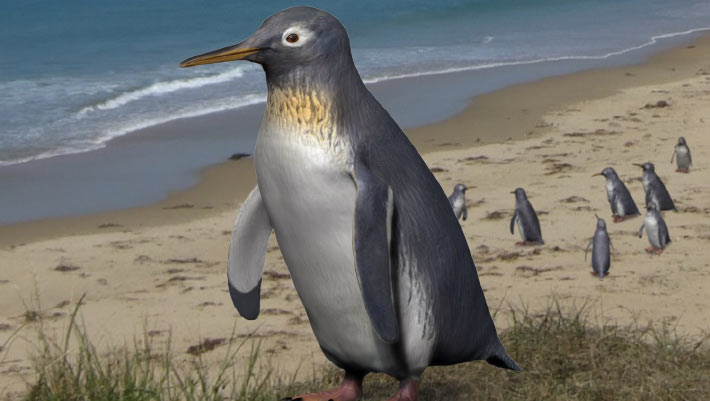Pakudyptes hakataramea would have been similar in body size to the living little blue penguin (Eudyptula minor), which is around 40-45 cm (15.7-17.7 inches) in length.
An artist’s impression of Pakudyptes hakataramea. Image credit: Tatsuya Shinmura / Ashoro Museum of Paleontology.
Pakudyptes hakataramea lived in New Zealand about 24 million years ago (Late Oligocene epoch).
The new species was very small — about the same size as the little blue penguin, the smallest in the world — with anatomical adaptations that allowed it to dive.
“Pakudyptes hakataramea fills a morphological gap between modern and fossil penguins,” said Dr. Tatsuro Ando, a paleontologist at the Ashoro Museum of Palentology.
“In particular, the shape of the wing bones differed greatly, and the process by which penguin wings came to have their present form and function remained unclear.”
“The humerus and ulna highlight how penguins’ wings have evolved.”
“Surprisingly, while the shoulder joints of the wing of Pakudyptes hakataramea were very close to the condition of the present-day penguin, the elbow joints were very similar to those of older types of fossil penguins.
“Pakudyptes hakataramea is the first fossil penguin ever found with this combination, and it is the ‘key’ fossil to unlocking the evolution of penguin wings.”
The fossilized remains of Pakudyptes hakataramea — a humerus, femur and ulna — were found in the Hakataramea Valley, South Canterbury by paleontologists Craig Jones and Professor Ewan Fordyce during a series of field trips in 1987.
“An analysis of the internal bone structure, with comparison with data on living penguins, shows these penguins had microanatomical features suggestive of diving,” said Dr. Carolina Loch, a paleontologist at the University of Otago.
Modern penguins have excellent swimming abilities, largely due to their dense, thick bones that contribute to buoyancy during diving.
In Pakudyptes hakataramea, the bone cortex was reasonably thick although the medullary cavity, which contains bone marrow, was open, similar to what we see in the modern little blue penguin, which tends to swim in shallow waters.
The ability for Pakudyptes hakataramea to dive and swim comes down to the distinctive combination of its bones.
“Penguins evolved rapidly from the Late Oligocene to Early Miocene and Pakudyptes hakataramea is an important fossil from this period,” Dr. Loch said.
“Its small size and unique combination of bones may have contributed to the ecological diversity of modern penguins.”
The discovery of Pakudyptes hakataramea is desribed in a paper in the Journal of the Royal Society of New Zealand.
_____
Tatsuro Ando et al. A new tiny fossil penguin from the Late Oligocene of New Zealand and the morphofunctional transition of the penguin wing. Journal of the Royal Society of New Zealand, published online July 31, 2024; doi: 10.1080/03036758.2024.2362283

